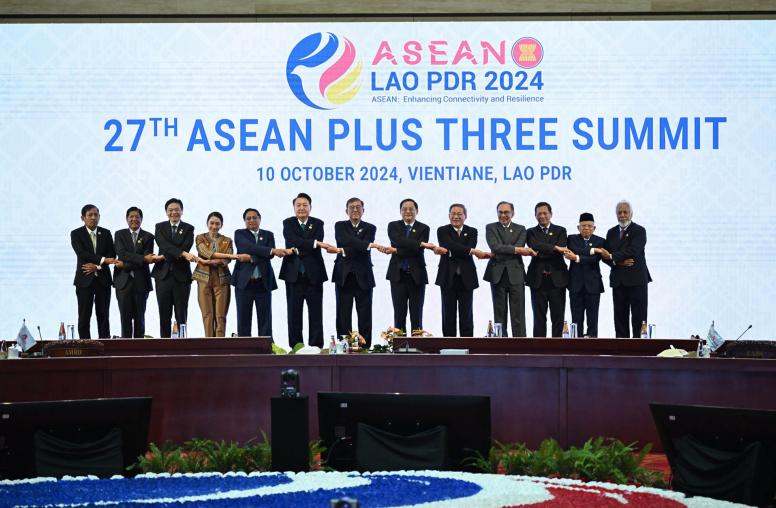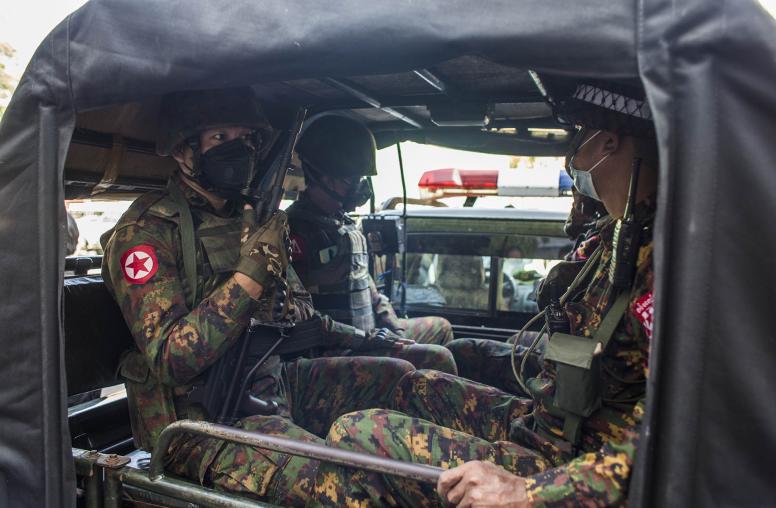Is Myanmar’s Junta Turning a Corner?
Until the new realities of power and politics sink in, any moves by the generals should be met with skepticism.
Are conciliatory winds stirring among the leaders of Myanmar’s coup regime, or is the junta engaging in deception and distraction as it struggles on the battlefield against a broad range of resistance forces? The answer is almost certainly the latter. It would not be the first time the ruling generals have sought to stimulate international interest in promoting dialogue solely to enhance their legitimacy abroad.

The current hope for cooling Myanmar’s brutal internal conflict stems from moves by the junta leadership to arrange a meeting between the Thai foreign minister and National League for Democracy (NLD) leader Aung San Suu Kyi and to ease the incarceration of NLD leaders. The military’s feints have sparked wide speculation that it may be opening the door to some form of political accommodation that would allow for elections next year. But those hoping for stabilization are bound to be disappointed. The regime is more likely simply playing the NLD card as a countermove to its recent military losses to ethnic armed organizations (EAOs) and civilian Peoples’ Defense Forces (PDF).
Unfortunately, the conditions for negotiating political solutions will not emerge until junta leaders recognize that the coup and its aftermath produced fundamentally new political realities: Negotiations will only take place once military leaders are prepared to withdraw from politics and agree to form a federal democratic government with the armed forces under the firm control of civilian leadership.
The coup regime faces an empowered, diverse generation of new leaders in the resistance movement. The ethnic armies, collaborating with PDFs at the operational level, have become more potent, expanding their territorial control, and jointly starting to pressure the military on all fronts simultaneously. As a collaborative movement, the resistance leaders are determined to break with past social and political patterns to stake out a new future for the country, one that honors diversity and turns it into a strength.
Transforming the resistance movement, with its often-countervailing internal pressures, into a federal democratic government, will require long, complex negotiations among all key actors. But one thing is certain: The old idea that a political solution can be achieved through military consolidation of power under the 2008 constitution or through negotiations between Burman military and civilian elites is no longer valid. Those in the international community still wedded to this formula will find soon enough it is not a productive path to resolving Myanmar’s conflicts.
Signs of Change in Naypyitaw?
As the junta regime in Naypyidaw approached the end of the extended state of emergency imposed on February 1, 2023, it arranged for Thailand’s outgoing foreign minister to meet with NLD leader Aung San Suu Kyi — her first engagement with a foreign dignitary since the civilian government was overthrown. Afterwards, her prison sentence and that of President U Win Myint were marginally reduced, and a rumor circulated that she and several other senior NLD leaders had been moved to house arrest. Rearranging the deck chairs on its sinking ship, the junta government reshuffled its civilian and military leadership, and the National Defense and Security Council extended the state of emergency for another six months, recognizing that they still hold too little territory to conduct national elections.
On the basis of these moves, some outside observers might conclude that the junta is seeking an accommodation with the NLD and Aung San Suu Kyi that would ease international pressure and create space for negotiations. What they are unlikely to appreciate is the battlefield beating the junta is taking is at the hands of the EAOs. More than anything, military failure may explain the junta’s moves — a bid to turn the spotlight on the NLD to cause fissures among the resistance forces, particularly between the EAOs and the National Unity Government.
Coup master Min Aung Hlaing and the generals around him are determined to keep using the 2008 constitution to legitimize their rule, despite having defied the constitution by staging the coup, disregarding its requirement for parliamentary approval of a state of emergency, and extending the emergency far beyond its constitutional limit. The military’s extreme violence against the civilian population and destruction of the country’s economic infrastructure over the past two years make it highly unlikely that Myanmar’s people will ever again acquiesce to the military’s role in government enshrined by the 2008 constitution.
In the eyes of the resistance movement, including key EAOs, the 2008 constitution is dead and beyond resuscitation. The future will demand an inclusive political contract and a new foundational document.
New Post-Coup Realities
Growth of EAO Strength and Territorial Control
The growing political and military power of Burma’s ethnic armed organizations constitute a fundamental new reality in the country. Prior to the coup, these groups had a variety of disagreements with the elected NLD government, and initially the junta seemed to calculate such hostility would make it easy to contain the EAOs with an offer of a renewed “peace process” and lip service to federalism and proportional representation.
But the coup and its subsequent violence against civilians prompted several EAOs — long engaged in conflict with the military — to reposition themselves politically. Many EAO leaders viewed the power grab as a complete abrogation of a peace process underway since 2011. Some EAOs also faced intense pressure from their communities to resist the blood-soaked military rule.
While the EAOs generally disapprove of the regime and its brutal suppression, they fall roughly into four distinct groups in their posture toward the junta and the resistance movement.
- The first group comprising four EAOs is openly aligned with the National Unity Government, a coalition of resistance forces. It includes the Kachin Independent Organization, Karen National Union, Karenni National Progressive Party and Chin National Front.
- The second group, known as the Three Brotherhood, tacitly supports the resistance movement, while consolidating its power and territories, and consists of the Arakan Army, Ta’ang National Liberation Army and Myanmar National Democratic Alliance Army
- The third group includes the remnants of the Nationwide Cease-fire Agreement of 2015, who have off-and-on discussions with the junta.
- A fourth group remains unaligned. It includes the powerful and fiercely independent United Wa State Army, Shan State Progressive Party and National Democratic Alliance Army. They are taking a wait and see attitude while carefully guarding their own autonomy.
According to our latest analysis, the EAOs field about 130,000 troops, representing a significant increase of manpower in recent years, and several have access to advanced weapons.
Despite their strategic differences, almost all well-established EAOs have incentives to support the resistance as they seek to weaken the military and pursue their own autonomy and territorial control. It is especially notable how badly army forces have been stretched by the apparent coordination between EAOs such as Kachin Independent Army and Karen National Union who cooperate with the NUG, and those in the Three Brotherhood, whose support for the resistance movement takes less formal form.
The net result is that multi-pronged EAO attacks are costing the military territory while the ethnic armed groups gain in strength and influence. In Myanmar‘s post-coup conflict, the security landscape has transitioned from a power struggle primarily between the NLD and the military to a multilateral one in which the EAOs are taking a place as additional key players.
Radical Change in Political Landscape
The other new reality is the emergence of a fresh generation of political leaders among both the Bamar majority and ethnic minorities who are determined to shed the social and political prejudices of the past and the military’s restrictions on intergroup contact. Shaped by the anti-coup movement, they are forging the kind of interethnic cooperation and coordination that the military studiously sought to prevent during its decades of dictatorial rule. They have even organized interim structures of governance to guide their quest for a federal democratic system.
To be sure, the issues among them are complex. At the forefront of this effort to forge a new governance are intense — but snail-paced — negotiations among various key elements of the resistance movement, including the interim National Unity Government, several EAOs and the National Unity Consultative Council. At the grass roots there is growing collaboration, and even battle-front integration, between certain large EAOs and young political activists who have formed PDFs.
Already the proposals under discussion have far transcended the provisions of the 2008 constitution and are inexorably aimed at creating a new one.
While parties to the talks — and particularly the NUG — develop their own ideas internally, any future agreement must be based on a true federal system of civilian governance that enables ethnic minorities to preserve their national identities and participate in federal democratic governance. It will require revamped security and political structures that serve the needs of true federalism.
Peacemaking Must Face New Realities
There are three new elements that must be considered in any steps seeking to end this conflict: (1) The ascendant ethnic armed organizations; (2) The young resistance leaders who have gained moral authority and political experience since the coup; and (3) The weakness of the armed forces itself, which has suffered militarily and politically from its ill-considered coup. These new post-coup realities cannot be disregarded.
Four key facts should guide any approach to peacemaking at the current stage.
- The junta regime has proved unable to control or contain the rapidly evolving post-coup situation and is unlikely regain the upper hand.
- Traditional notions that a political settlement could be achieved under the 2008 constitution or between the Burman NLD pro-democracy forces and the military alone are no longer valid.
- Those in the international community who wish to help resolve the current crisis in Myanmar must accept the new realities and find ways to work with them. Having foreign diplomats facilitate a negotiation between Bamar elites will be counterproductive in the changed political and security environment.
- Under present circumstances, the best preparation for future peace and stabilization is to encourage greater coordination within the resistance forces by supporting negotiation between pro-democratic forces and ethnic armed groups.
In short, it is too early for the international community to contemplate making peace between the junta regime and the powerful anti-coup resistance. However, anticipating a time when this may be possible, it would be useful for international actors to work holistically with key elements of the resistance to help them formulate an agreed structure for future governance.
Ye Myo Hein is a visiting scholar at the U.S. Institute of Peace and a global fellow at the Wilson Center.



